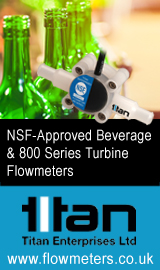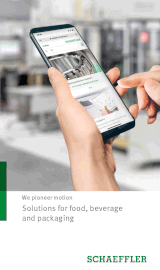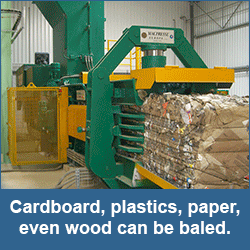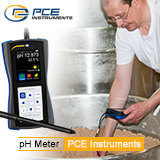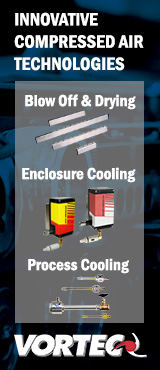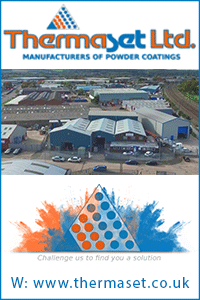INNOVATIVE LOAD CELLS OFFER A FRESH START TO FOOD PRODUCTION PROCESS
Developments in food production in recent years have resulted in more stringent hygiene requirements during the production process. Bernd Knoll, International Product Manager, explains these guidelines and looks at how the design of systems and the components involved play an important role in excluding micro-organisms from the production process.
Historically, preventive measures were not employed for microbial contamination of food during the processing cycle. Instead, the focus lay on the removal of micro-organisms after processing. However, in line with the recent trend for consumers to demand food that is fresh, untreated and without preservatives or other additives, it must now be virtually impossible for micro-organisms to enter any stage of the production process, making hygiene a crucial factor.
In line with these industry demands and the publication of the EHEDG (European Hygienic Engineering and Design Group) guidelines, a visible shift towards preventative measures rather than reactive hygiene measures has become common practice.
Up until recently, the development of load cells has been clearly focused on meeting the technical specifications such as quality and precision. However, as load cells continue to be used in environments which demand a high level of hygiene, such as the pharmaceutical and food industry, developers face a challenge.
In order to meet this challenge adequately, designers must first understand the basic microbiological influences in the production area. Although the most common contamination may originate in raw materials, the product may also be contaminated with micro-organisms during the actual production process itself, as a result of poorly designed equipment for instance, equipment may be difficult to clean meaning that residues may be retained in crevices or dead areas, allowing micro-organisms to survive and multiply; which can then cross contaminate subsequent batches of product.
Although load cells do not come into actual contact with products in automatic mixing and batching equipment, it is essential to counter creeping contamination and the resultant spreading of germs. With this in mind, components are now being developed that are both hygienic and also provide the necessary technical solutions; meaning that the principles for hygienic design are now being employed on all equipment in the direct vicinity of food processing equipment.
In order to comply with EHEDG guidelines and to avoid potential contamination, the housing of a load cell should be made completely of stainless steel alloy 1.4404 in accordance with AIS131L, which meets the requirements for corrosion resistance, mechanical stability and non-toxicity of components in contact with this product.
In addition, the material used must also demonstrate particularly high corrosion resistance, even in the case of exposure to solutions containing chloride, dependent on concentration and temperature. Lastly, the complete housing should have smooth, stainless steel surfaces that are non-absorbent and free from imperfection such as grooves and gaps, to avoid gathering, and an even surface structure with low surface roughness of less that 1µm, which is necessary to provide optimum cleaning.
Other features which also need to be considered when developing a hygienic load cell include:
- Welded joints – the micro-plasma welding process used should produce clean, smooth, welded joints with no roughness on which dirt may collect or become engrained. This would ensure the welded joints do not impair cleaning.
- Rounded corners – all corners should be rounded and not feature sharp edges. The adjustment chamber, for example, should be welded at the corners to ensure that sharp edges are avoided.
- Self draining – there should be no horizontal surfaces on any part of the housing. The upper section of the housing should have an inclined surface to enable water to flow freely away. The adjustment chamber should also be rounded to prevent water from remaining on the surface.
The PW25 and PW27 aseptic load cells from HBM have been specifically designed for use in weighing systems in the food and beverage industry. To meet the fundamental requirements with regards to cleaning, they are hermetically encapsulated and are manufactured in stainless steel which guarantees that the load cells are compatible with all the cleaning and disinfectant agents currently used by the food industry. The design of the load cells also makes it particularly easy to clean for example, the top surfaces are inclined to prevent the collection of dust, product residue or water droplets, while laser etching replaces the usual specification stickers. With daily cleaning likely to include disinfectant agents and/or high-pressure steam cleaning, the PW25 and the PW27 is also ingress protected to IP68, with IP69K as an option for added protection. Furthermore, the PW27 hygienic load cell from HBM is EHEDG certified making it suitable for the humid and aggressive conditions which are typical for applications within the food sector.
Although a primary objective of design is the need for the equipment to fulfil its engineering function, in the food sector there is the added imperative that food safety is never compromised. This means hygiene has to be taken into account in every part of the food manufacturing process, including the load cells. Upgrading equipment may require initial capital outlay, but the long term benefits of doing so could not only enhance product safety but also increase life expectancy of equipment, reduce maintenance costs and consequently lower overall operating costs.
For further information on the PW25 & PW27 aseptic load cells, contact HBM on +44 (0) 20 8515 6000 or via email: info@uk.hbm.co.uk or visit the HBM website at
Founded in Germany in 1950, HBM is today the technology and market leader in the field of test and measurement. HBM’s product range comprises solutions for the entire measurement chain, from virtual to physical testing. The company has production facilities in Germany, USA and China and is represented in over 80 countries worldwide.





